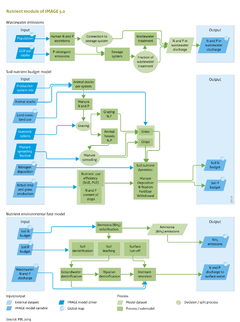Nutrients: Difference between revisions
Jump to navigation
Jump to search
No edit summary |
No edit summary |
||
| Line 4: | Line 4: | ||
|KeyReference=Bouwman et al., 2013a; Bouwman et al., 2009; Van Drecht et al., 2009; Morée et al., 2013; | |KeyReference=Bouwman et al., 2013a; Bouwman et al., 2009; Van Drecht et al., 2009; Morée et al., 2013; | ||
|Reference=Bouwman et al., 2013ab; Galloway et al., 2004; Zhang et al., 2010; Diaz and Rosenberg, 2008; UNEP, 2002; Rabalais, 2002; | |Reference=Bouwman et al., 2013ab; Galloway et al., 2004; Zhang et al., 2010; Diaz and Rosenberg, 2008; UNEP, 2002; Rabalais, 2002; | ||
|InputVar=Population - grid; GDP per capita - grid; Land cover, land use - grid; Animal stock; Livestock ration; Manure spreading fraction; Nitrogen deposition - grid; Actual crop and grass production - grid; Production system mix; | |InputVar=Population - grid; GDP per capita - grid; Land cover, land use - grid; Animal stock; Livestock ration; Manure spreading fraction; Nitrogen deposition - grid; Actual crop and grass production - grid; Production system mix; Fertilizer use efficiency; | ||
|Parameter=Fraction NH3 loss; | |Parameter=Fraction NH3 loss; | ||
|OutputVar=NH3 emission - grid; N and P discharge to surface water; Soil N budget - grid; Soil P budget - grid; | |OutputVar=NH3 emission - grid; N and P discharge to surface water; Soil N budget - grid; Soil P budget - grid; | ||
Revision as of 12:02, 24 February 2014
| Component is implemented in: |
| Components: |
| Related IMAGE components |
| Projects/Applications |
| Key publications |
| References |
Key policy issues
- How will the increasing use of fertilisers affect terrestrial and marine ecosystems, with possible consequences for human health?
- To what extent can the negative impacts be reduced by more efficient nutrient management and wastewater treatment, while retaining the positive effects on food production and land productivity?
